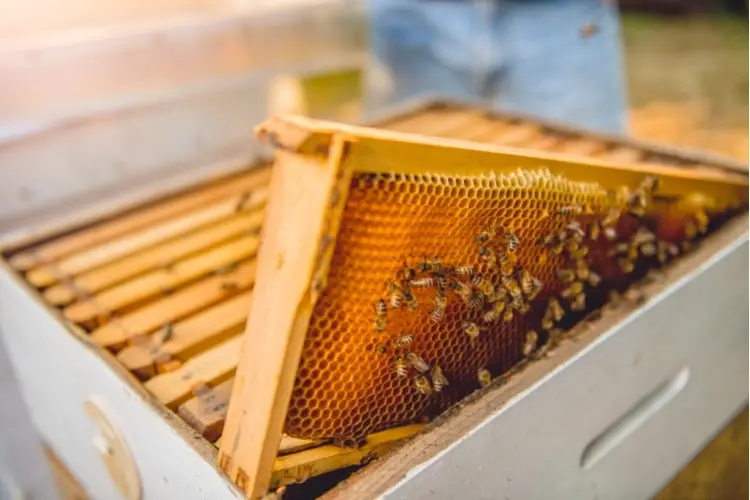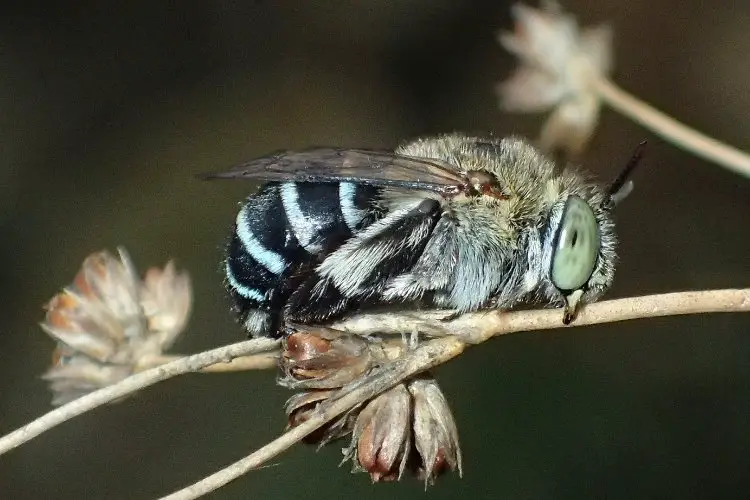Honey bees live in beehives or nests depending on whether they are wild (or feral) or domesticated. Bees used for beekeeping usually live in beehives. By comparison, feral honey bees settle in places like hollow trees and rock crevices that provide cover from predators and weather elements.
Do Bees Live In Hive Or Nests?
Both. Honey bees can thrive in nests and beehives. It depends on whether it’s a domesticated colony or a feral one because nests and beehives are different.
Beehive Vs. Bee Nest – What’s The Difference?
People often use these terms interchangeably; however, they mean different things.
Beehive is the name given to the manufactured structures designed by humans to keep honey bees. They usually consist of boxes with frames that provide bees a sheltered home where they can build comb and store resources. In contrast, nests are the structures bees make on materials they find in the wild.
Feral or undomesticated bees are more likely to live in areas with less human presence and build nests to live in the trees or natural elements they find. In contrast, honey bees that have been introduced to a beehive will happily settle there and grow used to humans passing by as long as they have access to flowers and water.


Bees can live in a beehive and then nest in the wild or vice versa. When a colony living in a beehive gets too big, the queen bee leaves the hive with about 50% of worker bees. This is called swarming and is the way honey bee colonies reproduce naturally. These swarm bees establish in a temporary place. At the same time, a group of workers known as scouts explore the area for an appropriate place to nest.
Wild bees can also settle in a beehive. This happens through the intervention of beekeepers when they capture a colony nesting in the wild and transfer it to a beehive. Sometimes bees decide to nest in inconvenient places, so beekeepers are called to move them to a more appropriate home.
Where Do Bees Live In The Wild?
Different species of bees nest in different places.
For example, honey bees in the wild choose to build their nests in hollow trees, under edges of surfaces or crevices. They pick areas where they can find food and water sources as well as protection from the weather and predators. Meadows, forests, and gardens offer plenty of flowering plants and sheltered spaces. So, it is common to find honey bee nests in these places.
On the other hand, species like the blue banded bee from Australia build nests in soft sandstone or mudbrick holes and soft mortar. Blue banded bees are solitary, which means they don’t belong to a colony. Instead, the females build their nests where they store nectar and pollen and take care of their brood.
Do All Bees Live In A Hive?
Not all honey bees live in hives. Only bees that have been born in beehives or have been transferred by beekeepers live in them.
Additionally, thousands of bee species haven’t been domesticated and therefore make their nests instead of settling in beehives.
Where Do Bees Live In Winter?
During winter, bees remain in their nest. They don’t look for other places to live. Doing so would be dangerous because honey bees can’t tolerate temperatures lower than -2°C (or 28°F). So instead, they look for a sheltered spot to establish when they swarm in spring and stay inside during the winter months. To prepare themselves for the low temperatures, bees build comb, produce honey and store it during spring and summer. Then, as the temperature lowers, the comb and honey act as insulation and energy, helping honey bees survive winter.
Therefore, an excellent home to establish is crucial to guarantee their survival during winter. Without one, they can’t store honey or protect themselves from the cold temperatures.
Do Bees Live Where They Sleep?
Honey bees live and sleep in the same place. This can be the nest they’ve built out in the wild or a beehive provided by a caring beekeeper. When the sun goes down, honey bees go back to their hive and sleep.
Some species of bees live and sleep in different places. For example, the male blue banded bees sleep outside. They hold on to a twig, stem, or edge of a leaf and curl their legs under their bodies when they go to sleep. This is common in solitary bee species where bees don’t live in big colonies. Instead, each female builds a nest for herself while the male bees will sleep in the open sheltered by plants, flowers, or any cover they can find.

